What is the average click-through rate for a Google Ads ad? When individuals ask this question, it's typically because they want to compare their own CTRs. But take note: far too many marketers are willing to get an average click-through rate and then leave it at that. If this describes you, simply glance at our search ad benchmarks graphic below and leave the post.
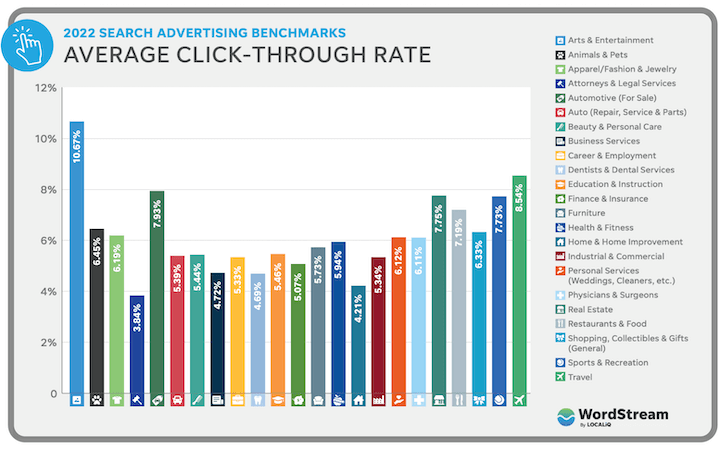 |
If, on the other hand, you want to maximize the effectiveness of your Google Ads and get the most out of your (or your client's) money, keep reading. In this piece, we'll show you why and why you should aim for an above-average click-through rate in Google Ads, as well as how to accomplish it..
What is click-through rate in Google Ads?
Click-through rate, in general, is a ratio of clicks to impressions. So in Google Ads, an impression occurs when your ad appears on the SERP, and a click occurs when the person viewing your ad clicks on it. Ergo, CTR is the percentage of people who see your ad who then click through to your ad’s destination (whether that’s to a landing page, app store, or lead form).
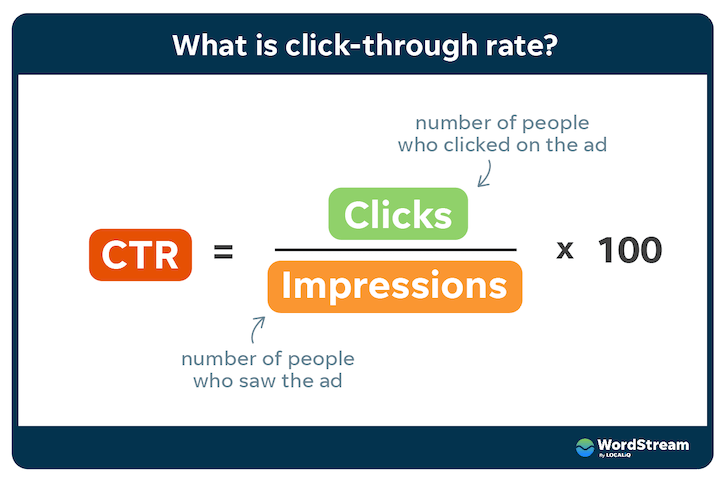 |
Why does CTR matter in Google Ads?
Click-through rate is a tricky PPC metric because while high click-through improves your Quality Score, you’re also paying for every click. Let’s dive into this a bit.
When high click-through rate is good
A high click-through rate in Google Ads is good because it’s an indicator that your ad copy is appealing to your audience.
But with the way Google Ads works, there is a deeper benefit. The Google Ads algorithm rewards higher quality ads with higher positions and lower costs per click. Why? Because Google doesn’t make money if no one clicks on its ads, so it gives preference to the ads most likely to succeed.
And how does Google measure the quality of ads? Its Quality Score formula is elusive, but we know its three core components:
- Relevance of the ad and landing page to the keyword.
- The landing page user experience.
- 👉 Your expected CTR. 👈
And there it is. Expected CTR is how Google estimates the ad to perform, regardless of position and other factors, taking into account your past performance with that keyword. According to Google, you can score an average, above average, or below average expected CTR for each keyword.
Soooo…..the higher your CTR, the higher your expected CTR, and the higher your Quality Score. Higher Quality Score leads to higher Ad Rank. Ads that rank higher get clicked more at lower costs. The lower your cost per click, the lower your cost per action.
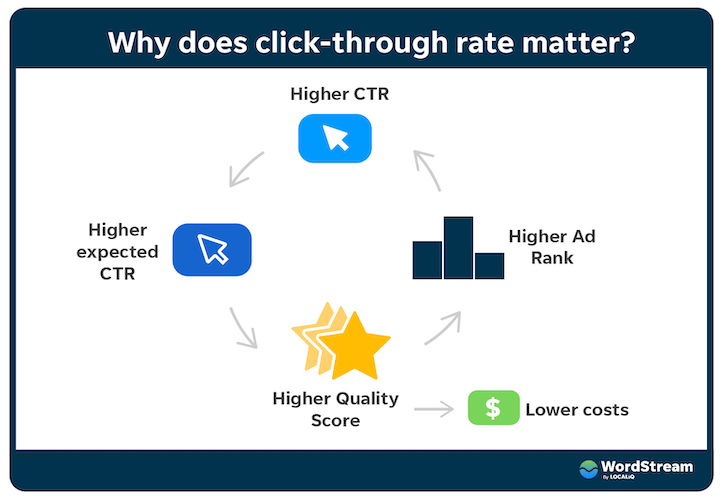
So how do you get an above-average click-through rate? We’ll get to that shortly. But first, a word of caution on high click-through rates.
When high click-through rate is…not good
Remember, this is pay-per-click advertising, so you are paying for every click on your ad, and not every click on your ad is going to convert. So a high click-through rate is a bad thing if you have a low conversion rate because you’re paying for clicks that aren’t going to result in a return on your investment.
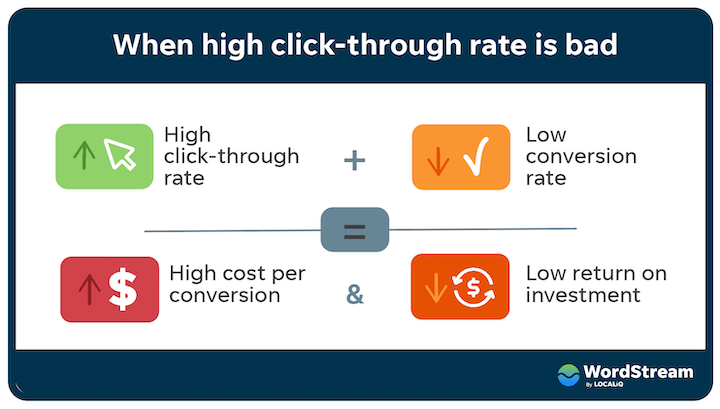
So your goal is not to get the highest click-through rate, but the highest qualified click-through rate possible.
But wait, one more thing.
Another piece in this equation is the keywords you’re bidding on. Some keywords come at a high price, such that even if those clicks are converting, you’re not yielding a return on investment with your ad spend. So ideally, you want a high click-through rate on keywords that are not just relevant, but also affordable.
What is a good CTR in Google Ads?
So, provided they’re relevant and affordable keywords, what is a good CTR in Google Ads? What does it take to land an “above average” score on your expected click-through rate? Let’s take a look back on the chart from the intro, which contains industry averages:

Catch our latest Google Ads benchmarks here.
Many industries have an average CTR of 4-6%. So a good or above average CTR in Google Ads is around 7-9%. But if you're in travel, car sales, or real estate with an average CTR of 7-9%, aim for 10-12%. But if you're in the arts and entertainment industry, where the average CTR is closer to 11%, you'll see 13% or higher. How to increase CTR in Google Ads
Now that we know what CTR is, how it affects your Google Ads performance, and what a good CTR means, let's talk about how to achieve it. And there are several ways. The first is your goal.
1. Select the right keywords
First, make sure you're selecting the right keywords. Here are three types of keywords you can use to increase your CTR:
Business-oriented keywords: Business-oriented keywords are keywords that people enter when they are in the mood to buy (for example, “best CRM” or “stainless steel dishwasher”). Don't use informational keywords like "what is CRM" as this can reduce click-through rates and/or waste money.
Branded keywords: This is another great option, not just your brand. Target your audience by partner brands, competing brands, or other brands that your target market might be searching for when you're in buying mode.
Local keywords: Local keywords like “personal trainer San Diego” tend to have a high CTR because local searchers tend to have a high commercial intent.
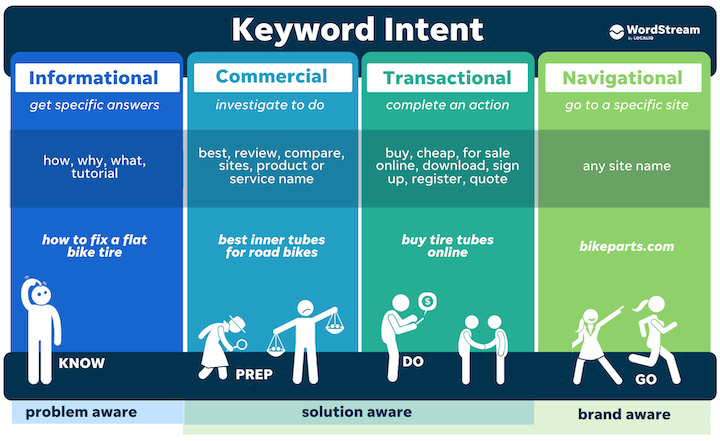
2. Use restriction keywords
This is necessary to check CTR. Negative keywords are keywords that you don't want Google to show ads for. For example, if you're selling new phones, you can set 'refurbished' or 'used' as your filter keywords. That way, your ad won't be shown to people who aren't likely to click on your ad.
3. Limit your targeting
If you're not running search ads or keyword ads (or if you are, but you're stratifying your audience), you might want to rethink your targeting. By narrowing down your audience to more specific criteria, you can better target your ad text and increase your click-through rate, even if you don't get as many clicks overall. How to increase your Google Ads CTR with ad copy
A low CTR may be due to the wrong keywords. But in most cases, you can significantly increase your CTR (and conversions… and ROI) simply by writing stronger ad copy. Exactly.
4. Keep it simple and concise
Unless it's a long traffic light sign, you can be sure that few ads are read in full, especially online. Keep your ads simple so they can deliver an effective message at a glance. That is all:
Include keywords in titles and descriptions, but don't repeat them.
Do not use the full number of characters if not necessary. Don't overcomplicate your ad with counterintuitive abbreviations.
Use simple, easy-to-read language.
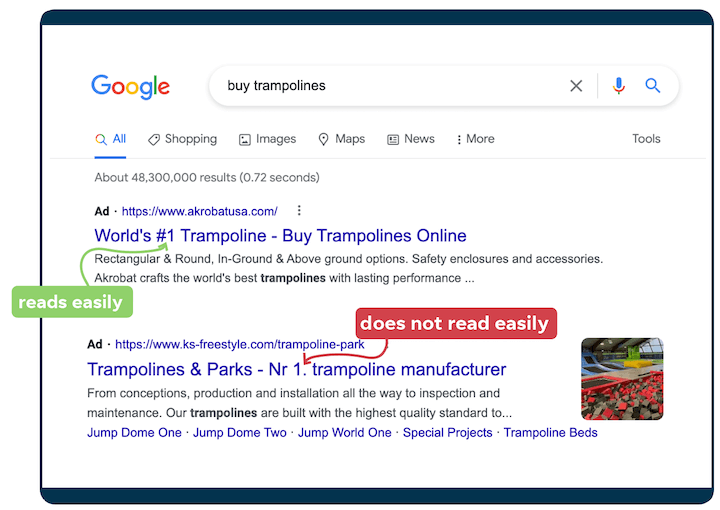 Plenty more Google Ads examples here.
Plenty more Google Ads examples here.
5. Actually have a CTA
Telling a user that you have what they're seeking for and that you have it better than your rivals is not a call to action. You must truly urge your ad viewers to take action. And to act right away. Purchase now. Download it now. Even if it's only one or two words, a micro-push may make all the difference.
Even better, include a feature or advantage in the CTA, such as "Start saving now" or "Speak with a professional now."”
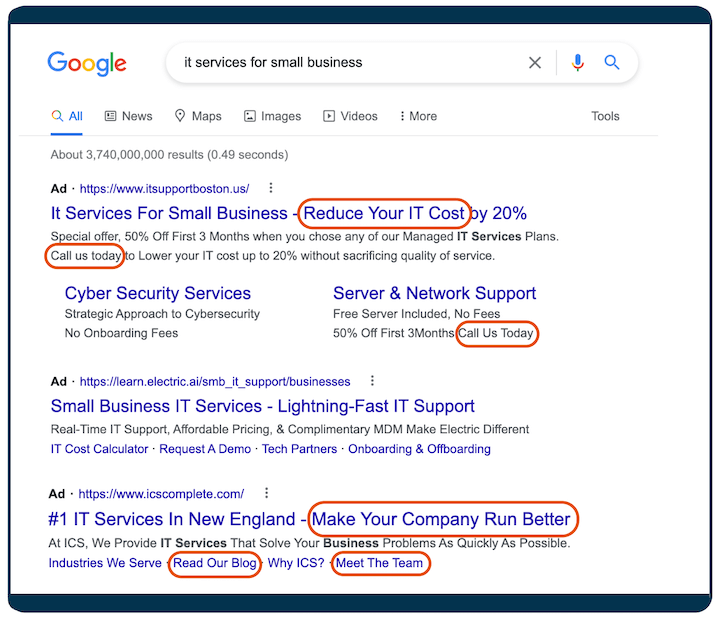
6. Put a special offer in your headline
Discounts and free delivery are popular special offers and promotions. Instead of mentioning them in the description, include them directly in your PPC headlines. The headline is the first (and sometimes only) item that searchers read. However, statistics in headlines always do well, and phrases like "free" fire up the human brain (like the elevator buttons when Buddy the Elf pushes them all at once).
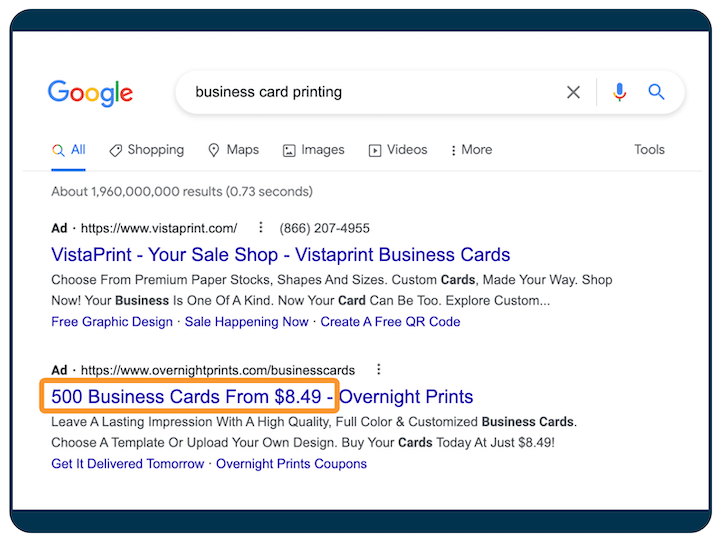
7. Put your main keyword in your display path
After the slash in your target URL, Google Ads display pathways emerge. Even if they are optional, you should definitely utilize them. Consider them an extension of your ad copy, and utilize them to contain your keyword. One of the instances below differs from the others. These display pathways might be used to communicate value or to convince the user that you have what they need..
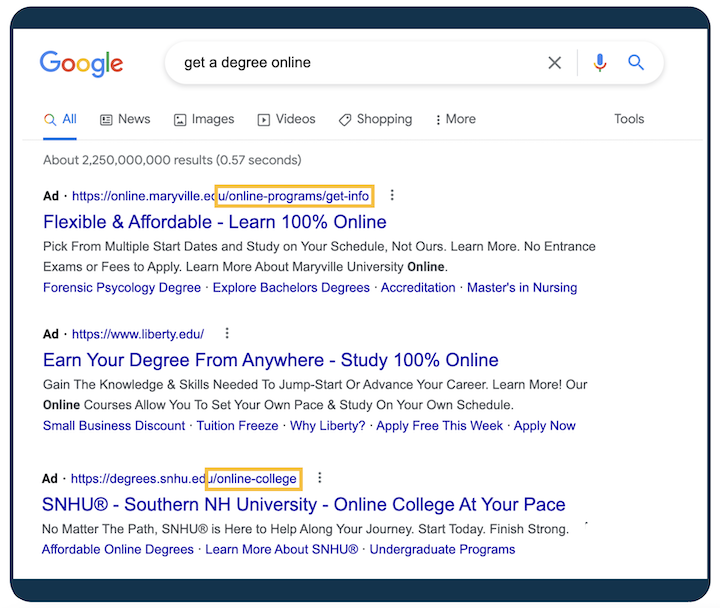
8. Create emotional ads
Emotional ad copy is a must for increasing your click-through rate. But the secret to emotional ad copy is to keep it subtle. No need for all caps, hyperbolic words, or exclamation points. Take a look at the two ads below for public speaking coaches, both with solid ad copy.
The first one uses terms like “best public speaking coach,” “level up your public speaking skills,” and “tailored.” That’s all well and good, but the second ad has more emotional words and phrases, like “Speak more confidently,” “Boost your career,” “live your best life,” and “unlock your potential.”
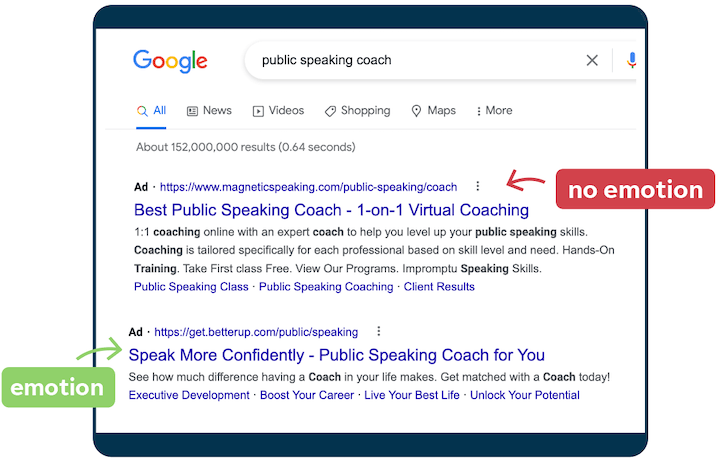
Not only is this more benefit-focused copy, but it’s also more emotional. Nothing extravagant, it just has feeling to it.
More ways to improve Google Ads click-through rate
These last methods originate from a study we performed using data from our Google Ads Performance Grader. We identified accounts that make up the top 15%, 5%, and 1% of performers in terms of click-through rate. Here’s what we found.
9. Use dynamic keyword insertion, but don’t overuse it
With dynamic keyword insertion (DKI), Google will automatically insert the keyword that triggered your ad into your ad copy or headline. This is beneficial, but only to a point, as illustrated from one of our studies below:
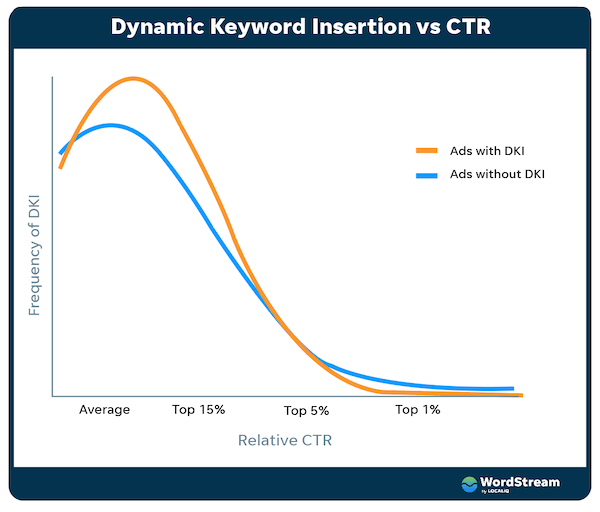
You can see that ads with DKI have a higher relative frequency than those without, but only for the top 15% of accounts. As you move to the top 5% and 1%, notice the red curve actually dips below the blue.
This tells us that DKI should definitely be part of your toolbox as it tends to produce slightly higher early returns, but it shouldn’t be overly relied on.
10. Use, but don’t rely on ad extensions
Google Ads extensions can help your ad take up more space on the SERP and give it more clickable appeal. In the same study, we found that accounts using sitelink extensions did slightly better than those that did not, which is not a surprise.

It’s a modest increase, but it won’t double or triple your click-through rates and it certainly won’t make up for boring ad copy. So just like DKI, use extensions but don’t rely on them.
11. Test more ads
In our study, we did some number crunching to see the relative abundance of ads with a higher than average click-through rate, and here’s what we found:
- Top 15%: These are ads with a 2x higher click-through rate, and they occur in one of every six or seven ads.
- Top 5%: These ads have a 3x higher CTR and occur once in every 20 ads.
- Top 1%: These have a 6x higher CTR and occur once in every 100 ads.
That’s right, 100 ads. No, you do not need to test 100 ads, but you do need to test lots of them. And yes, responsive search ads will do some ad copy testing for you by mixing and matching headlines and descriptions, but no—that doesn’t leave you off the hook for testing.
In her post on Google Ads mistakes, PPC influencer Michelle Morgan recommends always having 2-4 active ad variants in each ad group. To achieve higher-than-average click-through rates, you may want to bump that number up a bit. But don’t worry. We found that the top 5% of ads in an advertiser’s account makes up 85% of their impressions. So just choose your top two or three ad groups and focus on doing lots of testing there.
12. Pause the bottom third of your account
So…quick recap.
- High click-through rate = awesome.
- Low click-through rate = not awesome.
Why not delete the bottom third of your account and re-deploy that spend to remarketing? These are your low CTR, low impression share, and junk performers. Deadweight dragging you down. Cost per click is much lower on the Display Network, and if you’re using the display for remarketing, you can achieve similarly, and in some cases, even higher conversion rates than Search ads.
If you can get rid of the bottom third of your more expensive search ads and shift that spend to even average performing display and remarketing ads, that would be a brilliant way to begin to more effectively scale your Google Ads efforts.
Improve your Google Ads click-through rate
And there you have it. Average CTR is…well, average. Above-average CTR is the way to go (for relevant and affordable keywords, that is). Go this route and you’ll see higher impression shares, better ad positions, lower costs per click, and lower costs per conversion. Here is a recap of how to improve your click-through rate in Google Ads:
- Target the right keywords
- Use negative keywords
- Narrow your audience targeting
- Keep it simple and skimmable
- Actually have a CTA
- Put a special offer in your headline
- Put your main keyword in your display path
- Create emotional ads
- Use dynamic keyword insertion, but don’t overuse it
- Use, but don’t rely on ad extensions
- Test more ads
- Pause the bottom third of your account
